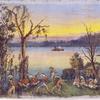Spilling Over: Painting Color in the 1960s
- NEW YORK, New York
- /
- November 01, 2018
The Whitney Museum of American Art announced its upcoming exhibitions for 2019. On the horizon are the 2019 Whitney Biennial—the seventy-ninth edition of the museum’s ongoing series charting the latest developments in American art—and major surveys devoted to artists Jason Moran and Rachel Harrison. In addition the Whitney will present Spilling Over: Painting Color in the 1960s, showcasing the work of artists such as Emma Amos, Sam Gilliam, Ellsworth Kelly, and Morris Louis, for whom color was at the center of their practice. April will bring the New York City debut of performance ensemble Moved by the Motion. And in the fall of 2019, the Whitney will join with The Museum of Modern Art and Public Art Fund in celebrating the work of Bucksbaum Award-winner Pope.L in a trio of complementary exhibitions.
“Following close on the heels of our historic Warhol retrospective, over the coming year the Whitney's program will focus primarily on living artists, who have been at the heart of our mission since the Museum's founding,” remarked Scott Rothkopf, Senior Deputy Director and Nancy and Steve Crown Family Chief Curator. “From the 2019 Biennial to genre-defying presentations by Rachel Harrison, Jason Moran, Moved by the Motion, and Pope.L, the Whitney will brim with a sense of daring innovation against the bedrock of our permanent collection.”
The one exhibition looking back, yet still feeling current in our own time of change, is Spilling Over: Painting Color in the 1960s which opens March 2019.
Painters in the 1960s faced a dilemma. Committed to the notion that color combined with gesture could still be an advanced form of artistic practice, they were forced to reckon with the newly-indelible legacy of Abstract Expressionism and the freshly-ascendant reign of Pop Art. After the painterly inventions of Jackson Pollock and the critical and cool precision of Andy Warhol, what could painting do? Spilling Over: Painting Color in the 1960s looks to the particular power of color to articulate questions around perception, race, gender, and the coding of space. Instead of bracketing artists by movement—using terms like Op Art and Color Field—the exhibition gathers paintings that differently employ direct, saturated, even hallucinatory colors to activate the viewer’s perception.
While contemporaneous accounts spoke in universal ways about perception, recent scholarship has looked to the personal, social, and political conditions that impact how we understand and speak about perception. Many of the artists in the exhibition were painting as active participants in the civil rights and women’s rights movements. Their—primarily abstract—paintings permit spaces for viewers to consider the politics of place and presence.
Drawn entirely from the Whitney’s collection, the exhibition includes important recent acquisitions by Emma Amos and Kay WalkingStick, as well as works by Helen Frankenthaler, Sam Gilliam, Marcia Hafif, Ellsworth Kelly, Morris Louis, and Bob Thompson. The title of the exhibition is taken from a quote by Thompson, who shortly before his death in 1966 said, “I paint many paintings that tell me slowly that I have something inside of me that is just bursting, twisting, sticking, spilling over to get out. Out into souls and mouths and eyes that have never seen before.” Spilling Over demonstrates why and how painting could still matter for artists who wanted to see anew.
The exhibition is organized by David Breslin, DeMartini Family Curator and Director of the Collection, with Margaret Kross, curatorial assistant, Whitney Museum of American Art.
M
















